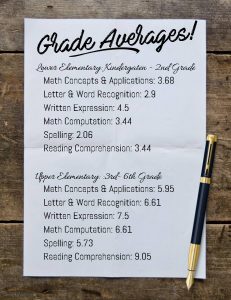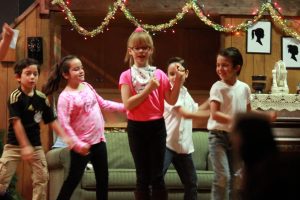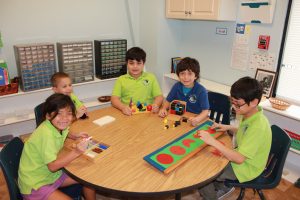Grades 1 to 8
The Montessori Elementary & Middle school curriculum inspires students to become independent learners who appreciate and understand their world. Integrated studies provide students with unique and age appropriate materials that help them to become accountable for their use of time, for accuracy in their work and to evaluate their strengths and areas of growth.
Our students have individualized work plans to allow them to use time effectively and to make appropriate choices. Students demonstrate great joy in their learning. Areas of study include Language Arts, Mathematics, Geometry, Physical Science, Biological Science, Geography, History, Fine Arts and Physical Education.
Assessments
• A summary of student performance by composite or subtest;
• Comparisons of skill areas or subtests for easy interpretation of results;
• Achievement/ability comparisons;
• Error analysis norms for all standard subtests;
• Suggestions for designing IEP goals based on Error Analysis results;
• Lists of math problems or reading or spelling words similar to those that were difficult for the student.
Language Arts
The Montessori Language Arts curriculum is designed to enhance the students’ skills in reading, comprehension, writing and speaking; and to provide connections with history, literature, science, math, and geography.
Reading – Students increase comprehension skills through various reading activities: reading silently and aloud to peers and teachers, reading cards, reading booklets related to academic studies, SRA, Junior Great Books and home reading.
Writing – Creative writing allows the student to express thoughts before spelling and grammar are mastered. As the student’s skills progress, sentence structure becomes more complex, spelling improves, and story-writing skills develop. Students write book reports, poetry and journals, and then learn to analyze sentences, build complex sentences and refine research skills.
Grammar – Students study the parts of speech and their functions using classical Montessori materials such as Grammar Boxes and the Farm. Definitions and symbols are correlated with each part of speech. Grammar studies are integrated to reinforce work the child has already mastered. For example, to play the Detective Adjective game, the child must be able to identify the scalene, isosceles and equilateral triangles; as well as obtuse, acute and right angle.
Spelling – Students study word families, create spelling lists, study word origins and meanings, and test their spelling skills. Nomenclature and sight words are practiced.
Handwriting – Print and cursive skills are reinforced through practice, journaling and class work.
Spanish – Since WOW is a bilingual school, Spanish lessons take place every day.
Foreign Languages – Students study foreign languages in small groups so that every student can participate in an oral and hands-on way. We incorporate Spanish, German and French.
Mathematics
The student entering an elementary Montessori program usually has a good math foundation. Elementary Montessori materials allow students to develop an in-depth understanding of math concepts followed by memorization of math facts. Students receive individual and small group lessons and work at their own pace. Math curriculum is organized so that students can independently follow the math sequence under the teacher’s guidance:
Addition
Subtraction
Multiplication
Division
Skip Counting
Memorization of Math Facts
Fractions
Determining common multiples & divisors
Finding the greatest common divisor
Squaring
Prime Factorization
Ratio/Proportion
Decimals
Percentages
Base Systems
Integers
Square Roots
Cube Roots
Estimation
Word Problems
Math History
Geometry – Comprehensive geometry studies begin with experiences with the line and its parts and continue through studies of angles, polygons, triangles, quadrilaterals, circles area and volume. The concepts of similarity, congruency and equivalency are also studied.
Physical Science
Our physical science program provide a strong sequential curriculum which integrates physics, chemistry, geology, astronomy, earth sciences and electricity. Studies include the use of lectures, discussion and experiments. Projects and research help students to understand abstract concepts. Some favorite activities include constructing electromagnets and models of planets, atoms and molecules.
The Universe – formation, nebulae, galaxies, gravity, laws of motion, Milky Way.
Solar System – the sun, the nine planets and their orbits.
The Sun – composition, sunspots, corona, flares, prominences, solar storms, solar winds, aurora borealis, aurora australis, source of energy (E=mC2), electromagnetic radiation spectrum, benefits & hazards of each band, eclipses.
Planet Earth – origin, inner structure, plate tectonics and effects, continental drift, volcanism, earthquakes (movement & consequences), tsunami, tides.
Matter – atomic structure, periodic table of elements, molecules, effects of gases on the human body, laws of physics (gravity, magnetism, nuclear forces), conservation of energy and of matter, radioactivity, nuclear power.
Electricity – concept, electric circuits, dry cells, light bulbs, definitions (volt, ampere, ohm, watt), test of conductive vs. non-conductive materials, test of electrostatic materials.
Magnetism – theory, examples of magnets, test of materials attracted by magnets, construction of electromagnet.
Biological Science
Botany – Many hands-on activities and experiments pique the students’ curiosity and engage them in the study of botany. Students study botany nomenclature and definitions, plant classification, biomes and ecosystems. Older students research native plants and help care for them in the environment.
Zoology – Students have a natural curiosity about the earth’s creatures. Zoology studies allow students to understand the system of organizing the animal kingdom and then delve into both vertebrate and invertebrate studies, including studies of the human body. Students also study cells, the nomenclature of external body parts and functions of internal organs and body systems. Independent research studies occur as student’s interests are piqued.
Geography
Geography studies are integrated with history and science. Students learn about many different cultures as they learn about other countries. Students also study the evolution of geography since the formation of the earth. Favorite activities include drawing maps and identifying countries, oceans, flora and fauna native to each continent.
The Earth: Timeline of life on Earth
Specific Geography Studies – Major land and water forms around the world: oceans, seas, lakes, rivers, volcanoes, mountains and islands, Physical, cultural, economic and political geography, flag studies, geology, and biomes.
History – History begins with the concept of the passage of time, then geologic time and the study of civilizations throughout history.
Fine Arts
Art – Art lessons are taught using various techniques and media.
Music – The music program uses a variety of sources and engages a wide range of music disciplines. Classes introduce students to well-known classical, world and jazz works and allows students an opportunity to discuss music history, vocabulary and theory.
Extracurricular Activities
Physical Education – Conditioning, strengthening, rules, cooperation and sportsmanship are taught, along with basic skills in a variety of activities.
Nutrition and Culinary Studies – Students learn the importance of nutrition and various techniques for making healthy edible dishes.



